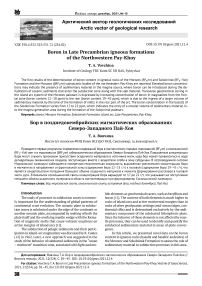Boron in late precambrian igneous formations of the Northwestern Pay-Khoy
Автор: Vovchina T.A.
Журнал: Вестник геонаук @vestnik-geo
Рубрика: Научные статьи
Статья в выпуске: 12 (324), 2021 года.
Бесплатный доступ
The first results of the determination of boron content in igneous rocks of the Morozov (RF3 mr ) and Sokolninsk (RF3-V sk ) Formation and the Morozov (bRF3 mr ) subvolcanic bodies of the northwestern Pay-Khoy are reported. Elevated boron concentrations may indicate the presence of sedimentary material in the magma source, where boron can be introduced during the dehydration of oceanic sediments that enter the subduction zone along with the slab material. Transverse geochemical zoning in the island arc system of the Morozov paleoarc is expressed by increasing concentration of boron in magmatites from the frontal zone (boron content 12-18 ppm) to the rear (boron content 19-45 ppm), which is due to the ingress of a larger volume of sedimentary material by the time of the formation of melts in the rear part of the arc. The boron concentration in the basalts of the Sokolninsk Formation varies from 17 to 22 ppm, which indicates the entry of a smaller volume of sedimentary material into the magma generation area during the formation of the Sokolninsk paleoarc.
Boron, morozov formation, sokolninsk formation, island arc, late precambrian, pay-khoy
Короткий адрес: https://sciup.org/149139297
IDR: 149139297 | УДК: 550.4:552.323:551.72 | DOI: 10.19110/geov.2021.12.4
Текст научной статьи Boron in late precambrian igneous formations of the Northwestern Pay-Khoy
The study of processes in subduction zones is extremely important for the understanding of global patterns of continental crust evolution. The oceanic plate in subduction zones is subducted under the edge of the continent or another oceanic plate, accompanied by melting of both the plate itself and the overlying mantle wedge with the formation of magmatic melts that cause volcanic eruptions on active margins of island arcs [11].
The subduction of pelagic sediments and their participation in island-arc magmatism was discussed by R. Coates [12] in 1962. Later, a new approach was suggested in the study of the behavior of subducted sediments in the “ocean – continent” transition zone, associated with light and mo- bile elements as geochemical tracers, such as beryllium and boron [11]. The content of both elements is much higher in rocks of island arcs and active continental margins than in rocks of other geodynamic settings (mid-ocean ridges, continental rifts) and is determined exclusively by the sedimentary component of the subducted lithospheric plate. Since the behavior of these elements is not affected by mantle processes, they can be used to identify and quantify the subducted sedimentary material in areas of plate convergence.
In this article, we presented novel data on the boron content in igneous rocks (basalts and basaltic andesites) of the Morozov and Sokolninsk Formation to assess the role of sedimentary material in subduction processes in this area.
Geological structure
The geological structure of the northwestern part of Pay-Khoy (Fig. 1) is formed mainly by island-arc formations of the Late Riphean-Vendian age, which are located in the core of the horst-anticlinorium of the Amderma block. The northeastern flank of the anticlinorium consists of carbonate deposits of the Amderma Formation (RF3-Vam), while the southwestern flank consists of volcanic-sedimentary and terrigenous rocks of the Morozov (RF3mr) and Sokolninsk (RF3-Vsk) Formation of the Morozov and Sokolninsk paleoarcs, respectively. The deposits of the Morozov Formation are also represented in the contours of individual tectonic blocks (Nyaruype and Nyadeipe massifs) in the southwest of the studied area. The internal structure of the Amderma block is complicated by a large near-meridional thrust in its eastern part. According to this thrust direction, the deposits distributed in the axial and southwestern parts of the block lies over the rocks composing its northeastern part. No stratigraphic transitions between the mentioned formations have been identified; all of them have tectonic contact with each other.
A. B. Kuznetsov and co-authors [7] found that on the isotopic composition of Sr and C in Precambrian carbonate rocks the Amderma Formation belongs to the Upper Riphean – Vendian age.
The age of the Sokolninsk Formation corresponds to the end of the Late Riphean – Vendian. This is concluded from the age of the youngest populations of detrital zircons: ~640 Ma from sandstones of the lower subseries and 650 Ma from tuff sandstones of the upper mass [6].
The age of the Morozov Formation was given as Late Riphean based on the obtained absolute values of the age of detrital zircons ~710 Ma [4].
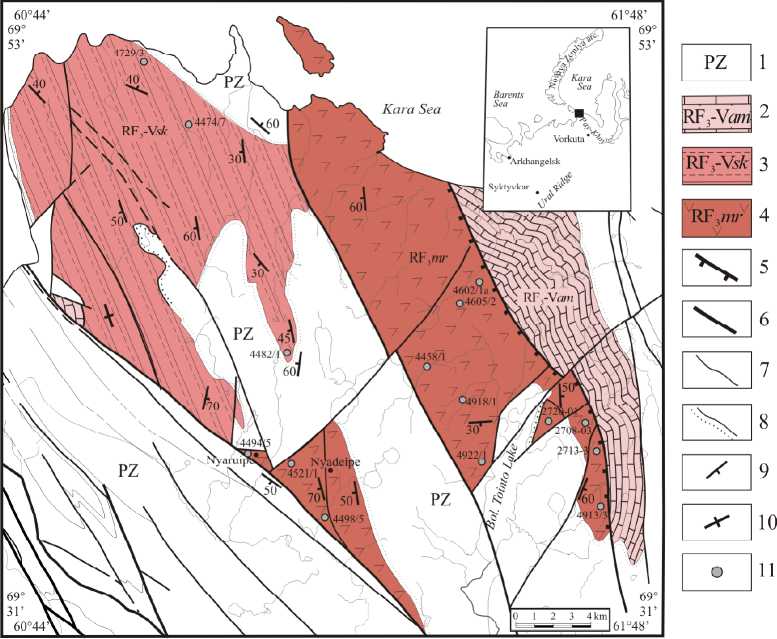
Fig. 1. Schematic geological structure of Amderma block, northwestern Pay-Khoy, compiled on the basis of materials of additional geological study, scale 1:200 000, Polyargeo Company [3], modified.
Legend: 1 – Paleozoic sediments; 2 – Amderma Formation (RF3-V am ): crystalline, microphytolithic limestones, rare chert lenses, fine-grained crystalline carbonaceous limestones; 3 – Sokolninsk Formation (RF3-V sk ) Sokolninsk paleoarc: sandstones, siltstones, gravelites, chert shales, tuffaceous sandstones, basalts, andesites, rhyodacites, rhyolites and their tuffs, subvolcanic rocks; 4 – Morozov Formation (RF3 mr ) Morozov paleoarc: shales, cherts and carbonaceous shales, limestones, dolomites, schistose felsic tuffs, basalts, andesites, basaltic andesites, rhyodacites, their tuffs, tuffaceous sandstones, subvolcanic rocks; 5 – thrusts; 6 – faults; 7–8 – geological boundaries: 7 – between units with conformable bedding, 8 – unconformity; 9–10 – structural units: 9 – inclined bedding, 10 – vertical bedding; 11 – sample points
Рис. 1. Схема геологического строения Амдерминского блока, Северо-Западный Пай-Хой. Составлена по материалам ГДП-200 ЗАО «Поляргео» [3], с изменениями.
Условные обозначения: 1 – палеозойские отложения; 2 – амдерминская свита (RF3-V am ): кристаллические, микрофитолито-вые известняки, редкие линзы кремней, тонкокристаллические углеродистые известняки; 3 – сокольнинская свита (RF3-V sk ) Сокольнинской палеодуги: песчаники, алевролиты, гравелиты, кремнистые сланцы, туфопесчаники, базальты, андезиты, риодациты, риолиты и их туфы, субвулканические образования; 4 – морозовская свита (RF3 mr ) Морозовской палеодуги: сланцы глинистые, кремнистые и углеродистые, известняки, доломиты, сланцы по кислым туфам, базальты, андезибазальты, андезиты, риодациты, их туфы, туфопесчаники, субвулканические образования; 5 – надвиги; 6 – разрывные нарушения; 7–8 – границы стратиграфических подразделений: 7 – согласные, 8 – несогласные; 9–10 – структурные элементы: 9 – наклонное залегание, 10 – вертикальное залегание; 11 – точки отбора проб
Small Late Proterozoic intrusive bodies are localized in the distribution zones of the Morozov (mafic subvolca-nic formations) and Sokolninsk Formations (acidic subvol-canic formations).
Throughout the section of the Morozov Formation, oval-elongated and lenticular subvolcanic formations of irregular shape and various lengths (100–1500 m) ( β RF3 mr ) are found, which are clearly expressed in the relief. Their age is conditionally accepted as Late Riphean based on their localization in the distribution zones of the Morozov Formation.
The Sokolninsk subvolcanic formations ( λζ RF3–V sk ) in outcrops are represented by a series of flat bedrock exposures and eluvial collapses up to 10 m. Their age is determined as Late Riphean based on the location of the bodies in the distribution zone of the lower subformation of the Sokolninsk Formation and the U-Pb age of zircons is 633 ± 14 Ma [2]. The obtained age is the same for dating detrital zircons from volcanomictic sandstones of the lower part of the Sokolninsk Formation [6].
Analytical methods
The mineral composition and textural and structural properties of the volcanic rocks were studied in transparent thin sections using OLYMPUS BX51 microscope. The gross contents of rock-forming components were measured by the chemical-analytical method. Boron was determined by the emission spectral method (analyst T. V. Yakimova) with DFS-8 spectrograph at the Collective Use Center Geonauka of the IG FRC Komi SC UB RAS [9], the content of other trace elements was determined by the ICP-MS method at VSEGEI [18].
Petrographic and petrogeochemical characteristics of rocks
The Morozov Formation contains a continuous series of magmatites ranging from basalts to andesites and their lithocrystal-clastic and crystal-lithoclastic psephytic-psam-mitic tuffs with an admixture of dacites, rhyodacites, and rhyolites.
Basalts and basaltic andesites of the main area of the formation distribution are characterized by porphyritic and serial-glomeroporphyritic structure and texture and microlitic, hyalopilitic structure of the groundmass (plagioclase, epidote-clinozoisite, chlorite (pycnochlorite and diabantite), augite grains, amphibole needles (actinolite, magnesian hornblende, barroisite) and leucoxene). Porphyritic phenocrysts are represented by saussuritized plagioclase and clinopyroxene of the “endiopside – diopside – augite” series.
Basalts and basaltic andesites of the Nyadeipe-Nyaruipe blocks are distinguished among the mafic rocks of the Morozov Formation according to textural and structural features: microporphyritic (up to aphyric) structure and a microamygdaloidal (more rarely ataxitic) texture. The structure of the groundmass is apointersertal.
Andesites have a serial-glomeroporphyritic structure (phenocrysts of fully albitized plagioclase forming clusters and intergrowths of crystals of one or several generations), a microfluidic texture, and a pilotaxitic structure of the groundmass (plagioclase, aggregates of chlorite, and carbonate matter).
The acidic rocks are characterized by a serial-glome-roporphyritic structure (phenocrysts of albitized and weakly sericitized plagioclase and quartz) and oriented schistose texture. The groundmass has a schistose texture and consists of a microgranular lepidogranoblastic quartz–feldspar aggregate with a small amount of sericite.
The tuffs have a lithocrystal-clastic and crystal-lithoclastic psephytic-psammitic structure and clastic texture. Crystal clasts are represented by saussuritized plagioclase and clinopyroxene. Lithoclasts of angular and isometric shape are mafic effusives with a porphyritic structure and amygdaloidal texture, intermediate composition with a pilotaxitic structure, and acidic composition with aphyric and rarely fine porphyritic structure.
The subvolcanic formations of the Morozov Formation are represented by basalts and basaltic andesites with specific rich-porphyritic structure and amygdaloidal texture. The abundance of large porphyritic short-prismatic phenocrysts of clinopyroxene (“endiopside – diopside – augite” series) up to 1.5 cm in size is characteristic for them compared to the effusive analogs of the main development zone of the Morozov Formation.
The chemical composition of the igneous formations of the Morozov Formation varies from picrobasalts to rhyodacites (Fig. 2, table 1). Most of the compositions correspond to the subalkaline series; rocks of intermediate and acidic composition belong to the series of normal alkalinity with variations from low-potassium to predominantly moderate-potassium and further up to high-potassium varieties. According to the TiO2 content, one can distinguish low-Ti varieties developed within the main zone of the formation, and high-Ti varieties that make up the Nyadeipe-Nyaruipe blocks among the rocks of the Morozov Formation.
On chemical composition, subvolcanic basaltoids are similar to effusive rocks of the mafic composition of the Morozov Formation, which may indicate their comagma-ticity [1].
Volcanic rocks in the Sokolninsk Formation form a continuous series from basaltic andesites to rhyodacites; there are also crystal-lithoclastic and crystal-vitroclastic psephyt-ic-psammitic tuffs of variable composition. A small amount of basalts and their lithocrystal-clastic psephytic-psammit-ic and psammitic-psephytic tuffs have been identified.
Basaltic andesites are characterized by a serial-glome-roporphyritic structure and amygdaloidal, rarely massive, texture. Phenocrysts are represented by fully albitized and sericitized plagioclase and individual grains of clinopyroxene. The microlitic groundmass (aggregates of albite and chlorite with leucoxene microclots) often retains a relic intersertal, microlitic, pilotaxitic, and hyalopilitic structure.
Andesites have a serial-glomeroporphyritic structure (phenocrysts of albitized, weakly chloritized, and saussuri-tized plagioclase and rare grains of clinopyroxene) and an oriented texture. The groundmass is composed of finegrained aggregates of albite and chlorite; sometimes elements of a relic intersertal structure are visible.
The acidic rocks have a porphyritic structure (phenocrysts of sericitized plagioclase and quartz with melted edges) with a lepidogranoblastic relict felsic and micropoikilit-ic groundmass structure and a fuzzy fluidal schist texture. The groundmass with relict felsic and micropoikilite structure is made up of micro- and fine-grained aggregates of albite and quartz with a small number of oriented sericite flakes emphasizing schistosity.
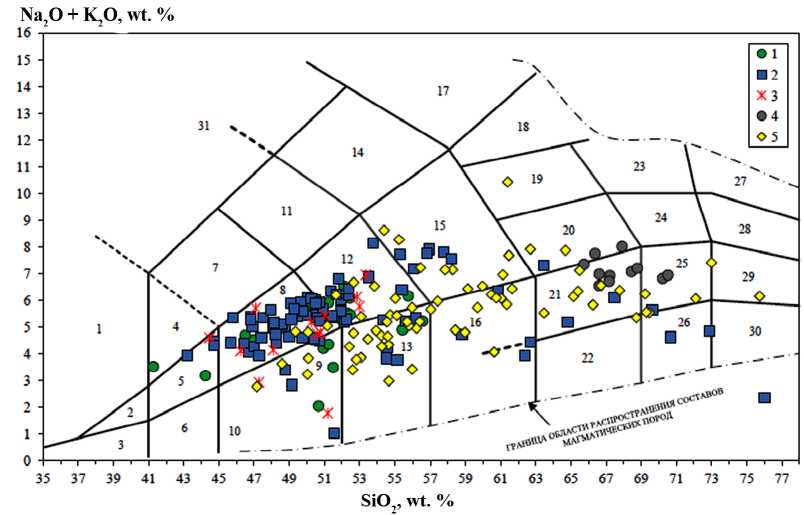
Fig. 2. Classification diagram (Na2O + K2O) – SiO2 (TAS) [8] for igneous rocks of the Morozov and Sokolninsk Formations.
Legend: 1 – subvolcanic formations of the Morozov Formation; 2 – low-Ti volcanic rocks of the Morozov Formation; 3 – high-Ti volcanics of the Morozov Formation (Nyadeipe-Nyaruipe blocks); 4 – subvolcanic formations of the Sokolninsk Formation; 5 – volcanics of the Sokolninsk Formation. Note: 1 – alkaline picrites; 2 – moderately alkaline picrites; 3 – picrites; 4 – alkaline picrobasalts; 5 – moderately alkaline picrobasalts; 6 – ultrabasic picrobasalts; 7 – alkaline basalts; 8 – trachybasalts; 9 – basalts; 10 – basic picro-basalts; 11 – phonothephritis; 12 – basaltic trachyandesites; 13 – basaltic andesites; 14 – tephriphonolites; 15 – trachyandesites; 16 – andesites; 17 – phonolites; 18 – alkaline trachytes; 19 – trachytes; 20 – trachydacites; 21 – dacites; 22 – low alkaline dacites; 23 – pantellerites (alkaline rhyodacites); 24 – trachyriodacites; 25 – rhyodacites; 26 – low alkaline rhyodacites; 27 – comendites (alkaline rhyolites); 28 – trachyrhyolites; 29 – rhyolites; 30 – low alkaline rhyolites; 31 – foidites
Рис. 2. Классификационная диаграмма (Na2O + K2O) – SiO2 (TAS) [8] для магматических пород морозовской и соколь-нинской свит.
Условные обозначения: 1 – субвулканические образования морозовской свиты; 2 – низкотитанистые вулканиты морозовской свиты; 3 – высокотитанистые вулканиты морозовской свиты (блоки Нядэйпэ-Няруйпэ); 4 – субвулканические образования сокольнинской свиты; 5 – вулканиты сокольнинской свиты. Примечание: 1 – щелочные пикриты; 2 – умеренно-щелочные пикриты; 3 – пикриты; 4 – щелочные пикробазальты; 5 – умеренно-щелочные пикробазальты; 6 – ультраосновные пикро-базальты; 7 – щелочные базальты; 8 – трахибазальты; 9 – базальты; 10 – основные пикробазальты; 11 – фонотефриты; 12 – трахиандезибазальты; 13 – андезибазальты; 14 – тефрифонолиты; 15 – трахиандезиты; 16 – андезиты; 17 – фонолиты; 18 – щелочные трахиты; 19 – трахиты; 20 – трахидациты; 21 – дациты; 22 – низкощелочные дациты; 23 – пантеллериты (щелочные риодациты); 24 – трахириодациты; 25 – риодациты; 26 – низкощелочные риодациты; 27 – комендиты (щелочные риолиты); 28 – трахириолиты; 29 – риолиты; 30 – низкощелочные риолиты; 31 – фоидиты
Crystal-lithoclastic psephytic-psammitic tuffs have an oriented texture. The lithoclastic material is represented by isometric and elongated fragments of aphyric and porphyritic volcanics of acidic, intermediate, and mafic composition. The phenocrysts contain grains of albitized plagioclase, less often quartz and potassium feldspar.
Crystal-vitroclastic aleuropelitic tuffs have a relict layered and secondary schist texture. The rocks underwent layer-by-layer carbonatization and albitization, but retained a small-clastic structure and consist of clastic ash material that has retained its primary shape and cement of similar composition.
The subvolcanic formations of the Sokolninsk Formation are represented by pyroxene-plagioclase dacites and rhyodacites with a serial-glomeroporphyritic texture and massive texture. The structure of the groundmass is fibrolepi-dogranoblastic.
The chemical composition of the Sokolninsk Formation volcanic rocks varies from basalts to rhyolites. On TAS diagram (Fig. 2, table 1), most of compositions are localized in the region of the normal alkalinity series; several points of mafic and intermediate composition lie in the field of the subalkaline series. According to the K2O content, the rocks are predominantly moderate-potassium (up to high-potassium varieties).
Most of the volcanic rocks of the Morozov and Sokolninsk Formations belong to the calc-alkaline series with the exception is the high-Ti basalts of the Morozov Formation of the Nyadeipe-Nyaruipe blocks, which correspond to the tholeiitic series.
Data on the chemical composition of rocks can be used to reconstruct geodynamic settings of their formation. Thus, the enrichment of volcanic rocks of the Morozov and Sokolninsk Formations in large-ion elements and the depletion in high-charge ones indicate that the magmatic melt from which the rocks crystallized was formed in a suprasubduction island-arc setting [5]. Higher concentrations of LILE in the rocks of the Sokolninsk Formation compared to the rocks of the Morozov Formation indicate that they were formed in a more mature island arc setting [5].
Volcanics of the Morozov Formation from the Nyadeipe-Nyaruipe block differ from the island-arc formations in sig- 41
Table 1. Content of petrogenic components (wt. %) and trace elements (ppm) in tne basaltoids of the Morozov and Sokolninsk Formations
Таблица 1. Содержание петрогенных компонентов (мас. %) и редких элементов (г/т) в базальтоидах морозовской и сокольнинской свит
|
Sample № пробы |
SiO 2 |
TiO 2 |
Al 2 O 3 |
Fe 2 O 3 |
FeO |
MnO |
MgO |
CaO |
Na 2 O |
K 2 O |
P 2 O 5 |
POI ППП |
Sum Сумма |
B, ppm B, г/т |
Ce, ppm Ce, г/т |
|
|
4913/3 |
50.94 |
0.37 |
14.92 |
1.97 |
5.74 |
0.12 |
10.44 |
7.46 |
3.07 |
1.13 |
0.06 |
3.77 |
99.99 |
40.00 |
6.00 |
|
|
4919/1 |
50.37 |
0.64 |
13.73 |
2.97 |
6.18 |
0.16 |
9.12 |
7.90 |
4.00 |
0.51 |
0.08 |
4.35 |
100.00 |
24.00 |
6.42 |
|
|
2741-01 |
1 |
51.24 |
0.36 |
13.88 |
1.36 |
7.67 |
0.17 |
6.13 |
6.98 |
5.87 |
0.05 |
0.08 |
4.57 |
99.12 |
11.00 |
5.16 |
|
4705/6 |
52.47 |
0.38 |
13.97 |
4.38 |
2.98 |
0.10 |
8.59 |
8.19 |
5.32 |
0.14 |
0.28 |
3.21 |
100.00 |
14.00 |
7.22 |
|
|
4720/1 |
50.67 |
0.33 |
8.63 |
0.21 |
6.85 |
0.17 |
14.47 |
12.53 |
2.01 |
0.03 |
0.05 |
3.07 |
100.00 |
12.00 |
5.55 |
|
|
2708-03 |
46.72 |
0.60 |
17.81 |
2.96 |
7.43 |
0.20 |
8.16 |
7.17 |
3.81 |
0.27 |
0.07 |
4.81 |
100.00 |
32.00 |
6.42 |
|
|
2713-01 |
45.82 |
0.44 |
13.10 |
2.04 |
5.24 |
0.15 |
7.13 |
12.38 |
4.06 |
1.30 |
0.08 |
7.33 |
99.59 |
27.00 |
9.96 |
|
|
2714-01 |
49.64 |
0.59 |
15.81 |
2.68 |
4.74 |
0.15 |
5.04 |
10.05 |
5.12 |
0.81 |
0.04 |
5.34 |
100.00 |
21.00 |
7.93 |
|
|
2720-01 |
49.49 |
0.43 |
17.03 |
2.05 |
5.81 |
0.18 |
8.05 |
6.76 |
3.48 |
1.91 |
0.06 |
4.75 |
100.00 |
45.00 |
8.80 |
|
|
2724-01 |
53.78 |
0.77 |
17.43 |
1.59 |
4.06 |
0.11 |
3.80 |
5.89 |
5.26 |
2.89 |
0.10 |
4.31 |
100.00 |
28.00 |
15.40 |
|
|
4458/1 |
53.51 |
0.64 |
17.14 |
2.18 |
6.03 |
0.14 |
4.92 |
5.17 |
6.47 |
0.40 |
0.08 |
3.32 |
100.00 |
18.00 |
14.40 |
|
|
4460/1 |
52.36 |
0.58 |
16.98 |
1.89 |
7.63 |
0.17 |
5.45 |
5.12 |
5.94 |
0.23 |
0.07 |
3.58 |
100.00 |
25.00 |
6.97 |
|
|
4521/2 |
49.76 |
0.80 |
14.59 |
3.87 |
7.05 |
0.18 |
7.51 |
6.77 |
4.00 |
0.59 |
0.13 |
4.75 |
100.00 |
39.00 |
21.60 |
|
|
4602/1а |
50.51 |
0.82 |
17.12 |
2.06 |
7.71 |
0.20 |
7.00 |
4.29 |
4.49 |
1.41 |
0.05 |
4.34 |
100.00 |
43.00 |
9.02 |
|
|
4603 |
2 |
48.23 |
0.56 |
17.59 |
2.31 |
6.17 |
0.17 |
7.29 |
7.81 |
4.55 |
0.16 |
0.07 |
5.09 |
100.00 |
19.00 |
6.66 |
|
4605/2 |
51.82 |
0.73 |
18.72 |
1.57 |
6.67 |
0.17 |
3.98 |
5.08 |
4.33 |
2.49 |
0.09 |
4.35 |
100.00 |
40.00 |
15.50 |
|
|
4913/13 |
50.94 |
0.37 |
14.92 |
1.97 |
5.74 |
0.12 |
10.44 |
7.46 |
3.07 |
1.13 |
0.06 |
3.77 |
99.99 |
29.00 |
6.64 |
|
|
491444 |
55.39 |
0.91 |
14.88 |
2.30 |
6.41 |
0.10 |
6.86 |
2.95 |
5.57 |
0.81 |
0.15 |
3.68 |
100.01 |
18.00 |
11.94 |
|
|
4918/1 |
51.36 |
0.31 |
15.01 |
0.67 |
5.15 |
0.12 |
5.37 |
8.10 |
5.09 |
1.25 |
0.14 |
7.42 |
99.99 |
16.00 |
9.69 |
|
|
4919/15 |
49.98 |
0.72 |
15.60 |
2.37 |
7.66 |
0.15 |
8.48 |
4.22 |
3.45 |
1.98 |
0.08 |
5.30 |
99.99 |
38.00 |
6.84 |
|
|
4920/8 |
50.51 |
0.58 |
15.89 |
1.60 |
6.59 |
0.14 |
7.37 |
5.71 |
4.68 |
1.19 |
0.14 |
5.59 |
99.99 |
23.00 |
8.58 |
|
|
4921/5 |
50.93 |
0.65 |
19.49 |
1.36 |
7.21 |
0.12 |
6.47 |
3.70 |
5.45 |
0.21 |
0.12 |
4.27 |
99.98 |
19.00 |
4.89 |
|
|
4922/1 |
46.79 |
0.54 |
14.77 |
1.97 |
7.22 |
0.14 |
7.11 |
7.19 |
5.07 |
0.22 |
0.05 |
8.93 |
100.00 |
12.00 |
5.96 |
|
|
4494/5 |
51.04 |
3.41 |
11.91 |
7.92 |
6.13 |
0.17 |
5.18 |
4.63 |
5.39 |
0.05 |
0.44 |
3.71 |
99.98 |
20.00 |
4.00 |
|
|
4498/5 |
3 |
55.14 |
0.35 |
12.07 |
2.72 |
8.04 |
0.18 |
8.18 |
5.17 |
3.72 |
0.05 |
0.03 |
4.34 |
99.99 |
19.00 |
2.31 |
|
4521/1 |
48.09 |
2.27 |
12.69 |
10.86 |
4.31 |
0.14 |
7.76 |
5.48 |
4.11 |
0.02 |
0.18 |
4.10 |
100.01 |
16.00 |
22.50 |
|
|
4474/7 |
52.66 |
0.77 |
16.27 |
2.24 |
6.42 |
0.16 |
6.25 |
6.02 |
3.76 |
1.01 |
0.09 |
3.33 |
98.98 |
22.00 |
13.80 |
|
|
4482/1 |
4 |
52.61 |
0.46 |
12.88 |
2.43 |
7.83 |
0.20 |
8.89 |
6.25 |
1.99 |
1.41 |
0.06 |
4.97 |
99.98 |
21.00 |
10.60 |
|
4729/3 |
51.66 |
0.97 |
16.76 |
1.89 |
6.84 |
0.16 |
5.13 |
5.92 |
5.93 |
0.27 |
0.18 |
3.30 |
99.01 |
17.00 |
13.00 |
Note: 1 – subvolcanic formations of the Morozov Formation; 2 – low-Ti volcanic rocks of the Morozov Formation; 3 – high-Ti volcanics of the Morozov Formation (Nyadeipe-Nyaruipe blocks); 4 – volcanics of the Sokolninsk Formation.
Примечание: 1 – субвулканические образования морозовской свиты; 2 – низкотитанистые вулканиты морозовской свиты; 3 – высокотитанистые вулканиты морозовской свиты (блоки Нядэйпэ-Няруйпэ); 4 – вулканиты сокольнинской свиты.
nificantly higher contents of highly charged elements [5], which indicates the melting of such melts in the back-arc spreading zone [10].
Boron content and its genetic indicativeness
Boron, as a light and mobile element, is a geochemical tracer to study the behavior of subducted sediments in the “ocean–continent” transition zones, which is important in the understanding of the global patterns of evolution of the continental crust. Since V. M.
Goldschmidt, it has been known that boron is an invariable component of marine sediments, and its elevated concentrations can indicate the presence of sedimentary material in a magma source. Boron could be attracted to the source of the melt during the dehydration of oceanic sediments that enter the subduction zone together with the slab material [11]. The boron content in island-arc lavas of basic composition is 2–90 ppm [15, 17]. This is significantly higher than its concentrations in volcanic rocks of other geodynamic settings with similar silicic acidity.
The boron enrichment of basalts and basaltic andesites is also related to the fact that the main boron concentrating minerals in igneous rocks – plagioclases and pyroxenes – are of basic paragenesis [3].
To analyze the behavior of boron in mafic igneous rocks of various geodynamic settings, we used the B/Ce – B diagrams [14], where the boron content is normalized to cerium as a low-mobility element, and B – SiO2 (Fig. 3, a, b). With dashed lines areas of boron content in igneous rocks (mainly in basalts) of continental rifts (1–3 ppm), island arcs (ensialic Kamchatka, 5–60 ppm, and ensimatic Mariana, 8–27 ppm) and mid-ocean ridges (2–40 ppm) are shown.
The chemical compositions were given according to the GEOROC database [13].
The boron content was determined in basalts and basaltic andesites of the Morozov (Morozov paleoarc) and Sokolninsk Formations (Sokolninsk paleoarc) of the northwestern Pay-Khoy to assess changes in the volumes of sedimentary material input during subduction. Transverse geochemical zoning is observed in the island-arc system of the Morozov paleoarc, expressed by an increase in the concentration of boron in magmatites in the direction from the frontal zone (boron content 12–18 ppm) to the rear zone (boron content 19–45 ppm) (Fig. 1, table 1), which is due
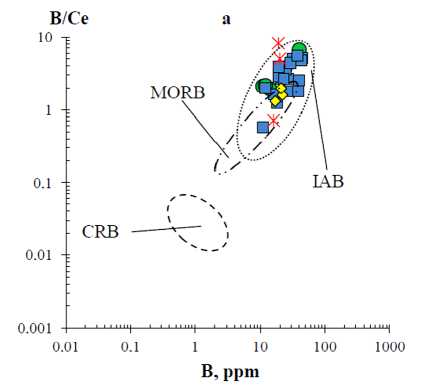
Fig. 3. Diagrams for basalts and basaltic andesites of the Morozov and Sokolninsk Formations: 1 – subvolcanic formations of the Morozov Formation; 2 – low-Ti volcanic rocks of the Morozov Formation; 3 – high-Ti volcanics of the Morozov Formation (Nyadeipe-Nyaruipe blocks); 4 – volcanics of the Sokolninsk Formation. Fields marked with ovals [13]: CRB – continental rift basalts; IAB – island arc basalts; MORB – mid-ocean ridge basalts
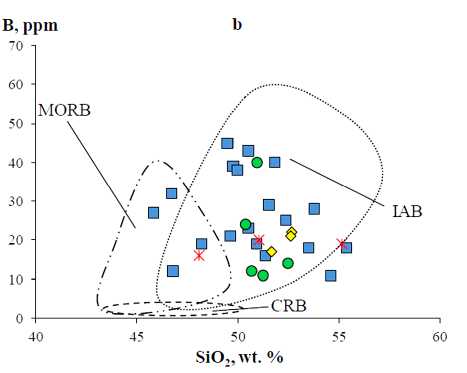
Рис. 3. Диаграммы для базальтов и андезибазальтов морозовской и сокольнинской свит: 1 – субвулканические образования морозовской свиты; 2 – низкотитанистые вулканиты морозовской свиты; 3 – высокотитанистые вулканиты морозовской свиты (блоки Нядэйпэ-Няруйпэ); 4 – вулканиты сокольнинской свиты. Поля, обозначенные овалами [13]: CRB – континентальные рифты; IAB – островные дуги; MORB – срединно-океанические хребты
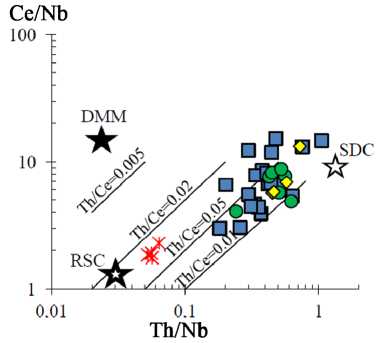
Fig. 4. Diagram Ce/Nb – Th/Nb [15]: DMM – depleted mantle;
RSC – residual component of recycled oceanic crust;
SDC – subduction component of island arcs. Legend – in Fig. 2
Рис. 4 . Диаграмма Сe/Nb – Th/Nb [15]: DMM – деплетиро-ванная мантия; RSC – остаточный компонент рецикли рованной океанической коры; SDC – субдукционный ком понент островных дуг. Условные обозначения – на рис. 2
to a larger volume of sedimentary material ingress by the time of the formation of melts in the rear part of the arc. The high-Ti basaltoids of the Nyadeipe-Nyaruipe block contain 16–20 ppm boron, while the basalts of the Sokolninsk Formation contain 17 to 22 ppm boron (Fig. 3, b), which indicates that a smaller volume of sedimentary material entered the magma generation zone during the formation of these rocks.
The involvement of marine sediments in the substrate for the melting of the volcanic rocks of these formations, in addition to the increased content of boron, is also confirmed by the behavior of other elements and their ratios.
Low-Ti volcanic rocks of the Morozov and Sokolninsk Formations have variations Th/Nb = 0.20–0.75 and Ce/Nb = = 5.3–15.19, which corresponds to the subduction component of the island arcs (Fig. 4) and indicate the formation of these rocks in a suprasubduction island-arc setting from upper-mantle sources similar in composition at close degrees of partial melting. Much lower values of Th/Nb (0.05–0.06) and Ce/Nb (1.7–2.3) have been found for high-Ti basalts of the Morozov Formation of the Nyadeipe-Nyaruipe Block, which are close to the residual component of the recycled oceanic crust (RSC). Therefore, the high-Ti basalts 43
of the Nyadeipe-Nyaruipe block were formed in the suprasubduction spreading zone from a deeper mantle source with an admixture of a recycled component [5].
Conclusions
A study of the behavior of boron in igneous rocks (basalts and basaltic andesites) of the Morozov and Sokolninsk Formations showed that this component entered the source of the melt during the dehydration of oceanic sediments, which sank together with the slab material into the subduction zone. The presence of a sedimentary component in the substrate for melting volcanic rocks is also confirmed by the behavior of other elements and ratios.
Transverse geochemical zoning is observed in the island-arc system of the Morozov paleoarc, expressed by increasing concentration of boron in magmatites in the direction from the frontal zone (boron content 12–18 ppm) to the rear zone (boron content 19–45 ppm), which is due to the ingress of a larger volume of sedimentary material by the time of formation of melts in the rear part of the arc. In the basalts of the Sokolninsk Formation, fluctuations in the level of boron concentrations are lower (17–22 ppm), which indicates that fewer sediments were involved in the magma generation area during the formation of the Sokolninsk paleoarc.
The obtained results prove that boron can be one of the important indicators of participation of sedimentary material in the generation of subduction magmas.
The work was carried out in the context of the research topic “The lithosphere of the northeast of the European Platform and the north of the Urals: material and structural evolution, correlation of geological events, geodynamics, geochronology”. GR No. AAAA-A17-117121270035-0.
Список литературы Boron in late precambrian igneous formations of the Northwestern Pay-Khoy
- Vovchina T. A., Soboleva A. A. Rezultaty U-Pb (SIMS) datirovaniya cirkona iz pozdnerifejskih plagiogranit-porfirov severo-zapadnogo Pay-Khoya (Results of U-Pb (SIMS) dating of zircon from Late Riphean plagiogranite-porphyries of northwestern Pay-Khoy). Proceedings of Komi SC UB RAS, No. 1 (41), Earth sciences. Syktyvkar, 2020, pp. 88-95. DOI: 10.19110/1994-5655-2020-1-88-95.
- Vovchina T. A. Pozdnerifejskie morozovskie subvulkanicheskie bazaltoidy severo-zapadnogo Pay-Khoya (Late Riphean Morozovian subvolcanic basaltoids of the northwestern Pai-Khoi). Proceedings of conference, 2020, 17, pp. 76-80. DOI: 10.31241/FNS.2020.17.014.
- Grigorev N. A. Raspredelenie khimicheskikh elementov v verkhnei chasti kontinentalnoi kory (Distribution of chemical elements in the upper part of the continental crust). Ekaterinburg: IGG UB RAS, 2009, 382 p.
- Zarhidze D. V. Geologicheskoe doizuchenie masshtaba 1:200000 listov R-41-XX, XXI (Amderminskaya ploshchad) (Geological additional study of scale 1:200000 sheets R-41 -XX, XXI (Amderma area)). Report, MIREKO, Syktyvkar, 2014.
- Kaneva T. A. Petrogenezis i geodinamika pozdnedokembriyskih vulkanitov severo-zapadnogo Pay-Khoya (Petrogenesis and geodynamics of volcanic rocks late precambrian the northwest Pay-Khoy). Vestnik of Institute of geology Komi SC UB RAS. 2016, No. 12, pp. 3-15. DOI: 10.19110/2221-1381-2016-12-3-15.
- Kaneva T. A., Udoratina O. V., Starikova E. V., Khubanov V. B. Ocenka nizhnego vozrastnogo predela neoproterozoiskoi sokolninskoi svity severo-zapadnogo Pay-Khoya na osnove U-Pb datirovaniya detritnyh cirkonov (Evaluation of lower age limit of Neoproterozoic Sokolninsk Formation in northwestern Pay-Khoy based on detrital zircons U-Pb dating). Bjul. Mosk. obsch-va ispytateley prirody. Otd. Geol. (Bulletin of Moscow society of naturalists. Geology series). Moscow: MSU, 2015, V. 90, V. 6, pp. 3-10.
- Kuznetsov A. B., Starikova E. V., Maslov A. V., Konstantinova G. V. Sr-izotopnaya hemostratigrafiya dokembriyskih carbonatnyh porod Amderminskogo podnatiya, Pay-Khoy (Sr Isotopic Chemostratigraphy of Precambrian Carbonate Rocks in the Amderma Uplift, Pay-Khoy). Doklady Earth Sciences, 2016, V. 246, No. 4, pp. 447-451.
- Petrograficheskij kodeks Rossii. Magmaticheskie, metamorficheskie, metasomaticheskie, impaktnye obrazovaniya (Petrographic Code of Russia. Magmatic, metamorphic, metasomatic, impact formations). St. Petersburg: VSEGEI, 2008, 200 p.
- Unificirovannye metody analiza silikatnyh gornyh porod s primeneniem kompleksonometrii (Unified methods of analysis of silicate rocks using complexometry). Moscow: Institute of mineral raw study, 1979, 33 p.
- Frolova T.I., Burikova I. A. Magmaticheskie formacii sovremennyx geotektonicheskix obstanovok (Igneous formations of modern geotectonic settings). Moscow: MSU, 1997, 320 p.
- Cvetkov A. A., Volynec O. N., Morris Dzh., Tera F., Rajan Dzh. Problema subdukcii osadkov v svete dannyx po geoximii berilliya i bora v magmaticheskix porodax zony perexoda okean-kontinent (The problem of sediment subduction in the light of data on the geochemistry of beryllium and boron in igneous rocks of the ocean-continent transition zone). Procedings of Academy of sciences of the USSR. Geology, No. 11, Moscow, 1991, pp. 3-25.
- Coats R. R. Magma type and crustal structure in the Aleutian arc. The crust of the Pacific Basin. Eds. G. A. Macdonald and H. Kuno. AGU. Washington D.C., 1962, pp. 92-109.
- GEOROC (www.georoc.mpch-mainz.gwdg.de/georoc)
- Jan C.M. De Hoog, Ivan P. Savov. Boron Isotopes as a Tracer of Subduction Zone Processes. Boron Isotopes, Advances in Isotope Geochemistry, 2017, pp. 217-247.
- Leeman W.P. Boron geochemistry of oceanic arc magmas: evidence for recycling of subducted oceanic lithosphere. (Abstr.). EOS. Trans. Amer. Geophys. Union, 1987, V. 68, No. 4, pp. 462.
- Saunders A. D., Norry M. J., Tarney J. Origin of MORB and chemically-depleted mantle reservoirs: trace element constrains. J. Petrol., 1988, Spec. Lithosphere Iss., pp. 415-455.
- Wedepohl К.Н. The Composition of the Continental Crust. Geochimica et Cosmochimica Acta. 1995, V. 59, No. 7, pp. 1217-1232.
- 18.https://vsegei.ru/ru/activity/labanalytics/lab/lab-operations/masspec.php.

